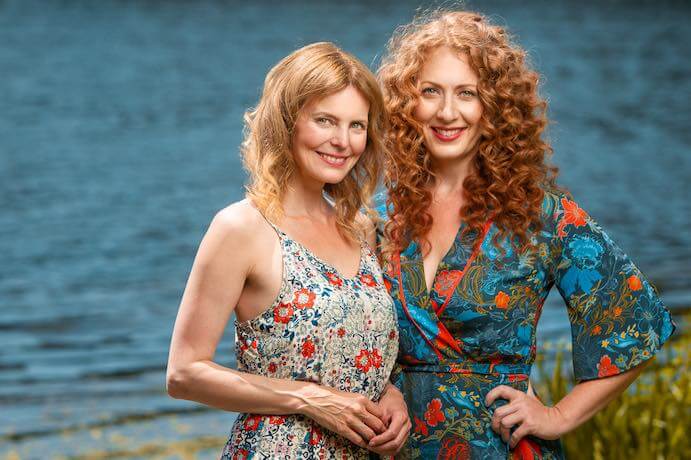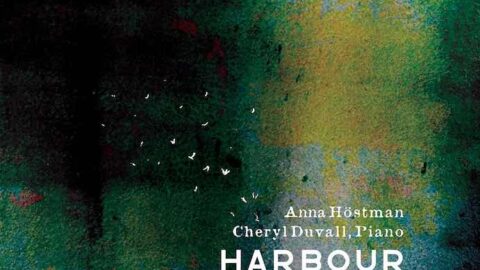Pianist Cheryl Duvall and composer Anna Höstman have an enviable collaborative relationship—one that affords Duvall interpretive freedom and Höstman fronts for compositional exploration. Their most recent project, their debut full-length album Harbour (released January 2020, Redshift Records) is a testament to their fruitful artistic partnership. Over the course of the album, which covers a ten-year period, Höstman explores the piano’s potential as a canvas for her sparse writing, a compositional voice that is minimal in its use of musical resources if not in its style. Duvall executes Höstman’s atmospheric, gestural writing with an ease that belies the focus and awareness that the music needs in order to come together on the part of the performer. Duvall has received three of the composer’s (so far) seven dedications of piano works, and has a particular flair for capturing the intimacy of the soundscapes that Höstman explores.
The album’s six pieces divide neatly in half: three have the benefit of some time and a few performances under their respective belts: darkness. . . pines (2010), allemande (2011), and harbor (2015); three are freshly-minted in 2019: late winter, yellow bird, and adagio.
darkness. . . pines (2010) is an exercise in chordal harmony, though one with little reference to a progression or anything like a resolution. Höstman’s chosen color palette pulls all of the focus: it’s sparse with subtle color changes, like brushstrokes on a Rothko color field. The chords are closely-orchestrated; she’s not playing with extremes of range or dynamics. She applies dissonances liberally, but not jarring or dramatic ones. They advance and retreat as facts of her tonal language, not as strong declarations.

The title of allemande (2011) alludes to the dance of Renaissance and Baroque fame, but Höstman only borrows the most stripped-down version of the frame of the original dance structure. There are moments of rhythmic pulse and motivation, but each disperses back into the a-metric landscape that it rose from. It’s easy to imagine a dancer’s choreography accompanying the solo piano—perhaps suggested by the title—but it’s a much less stylized choreography than would have paired with a historical allemande. Toward the end, the consistent presence of sequences of dotted rhythms nods to the allemande, as well, but quickly returns to more dissonant and thickly harmonized versions of the gestures from the opening.
Where allemande opens with long, sparse gestures, harbour (2015) takes quite a different approach. At 25:58, it’s by far the longest and clearly the featured piece. harbour also seems to mark a turning point in Höstman’s relationship with the piano. Her style is still gestural, but much more decisive than it is in the exploratory approach she has taken in allemande and darkness. . . pines. Her harmonic ideas reach back to darkness. . . pines and to chords that wouldn’t sound out of place in Monk and Coltrane charts, but harbour is where Höstman takes full advantage of the range of notes and dynamics that the piano offers her, and Duvall has the facility to execute what she asks for.
Two of the most recent pieces, late winter and yellow bird, are separate works but pair well based on their contrasts. At 4:18 and 7:16 respectively, they are more like short character pieces than the larger, exploratory studies that Höstman has previously favored. late winter premiered in June 2019 and is unique among Harbour’s pieces as the only one for piano left hand. Smooth, impressionistic, and intensely contemplative, this is neither an idle nor a light listen, and it takes “stark” to an extreme for the piano. Any harmony present is maintained more by the sustain pedal than by any simultaneous occurrences. yellow bird, which Duvall premiered in February of 2019, takes a similar approach to late winter in the beginning, though it takes up much more sonic space and rhythmic movement. Where late winter is nearly static, yellow bird is mobile and playful; where late winter evokes a panoramic, nearly monochrome landscape, yellow bird evokes a single, bright sapsucker or goldfinch.

Duvall premiered the final track, adagio, in May 2019. Ironically, it is the most conservative piece on the album. A movement or piece marked “adagio” can often signal a break from established forms or conventions; since Höstman’s established form on Harbour has been gesture, the steady, metric repetition of a narrow range of notes becomes a departure where it would otherwise have been de rigueur. For all its unassuming convention, adagio might be the freshest work on the album—whether this comes from its novelty relative to the other pieces, the strength of the composer’s writing, or both, is open for debate. adagio fits Höstman’s voice well, and Duvall carries the weight of it off with ease, never dispassionately, and always with poise.
Harbour as an album is deceptively quiet and contemplative. This is not a “background listening” album, but one perhaps best appreciated in a large, otherwise-silent room, or in the small hours of the morning. Ultimately, this Höstman-Duvall collaboration affirms what levels of expression quiet music is capable of when it is not forced to shout, but rather allowed to unfold on its own terms.
























